Chainsaw pruning is an effective way to keep your small garden looking neat and tidy, while also promoting healthy tree growth. However, it can be intimidating to use a chainsaw for pruning, especially if you’re new to gardening or have never used a chainsaw before. In this article, we’ll cover the basics of chainsaw pruning techniques for small gardens, including safety tips, selecting the right chainsaw, and optimizing your pruning time.
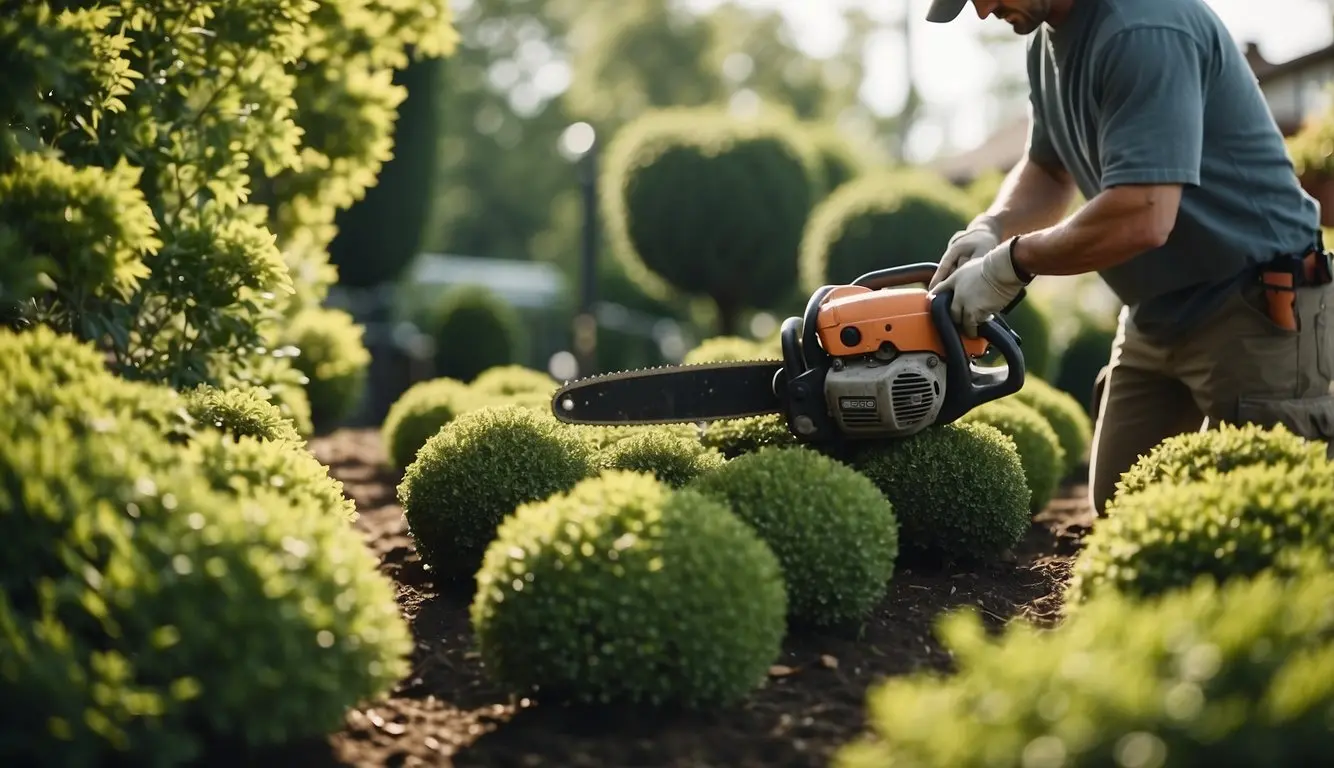
Before you begin chainsaw pruning, it’s important to understand the basics of tree growth and the proper techniques for pruning. This will help you achieve the best results for your garden while also minimizing the risk of damage to your trees. Safety is also a top priority when using a chainsaw, so we’ll cover the necessary precautions you should take before you start pruning.
Key Takeaways
- Understanding the basics of tree growth and pruning techniques is essential for effective chainsaw pruning in small gardens.
- Safety should always be your top priority when using a chainsaw, so take the necessary precautions before you start pruning.
- Selecting the right chainsaw and optimizing your pruning time can help you achieve the best results for your garden.
Table of Contents
Understanding Chainsaw Pruning
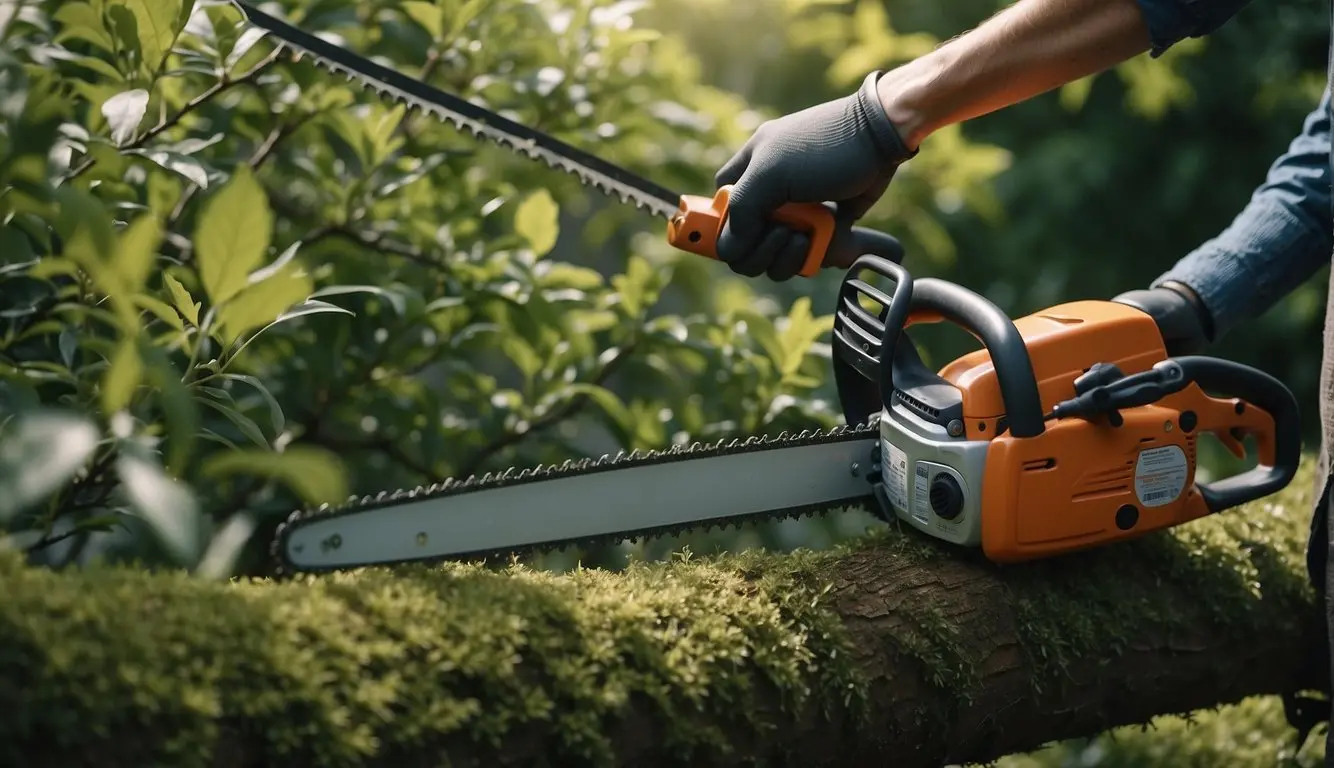
If you have a small garden, you may think that using a chainsaw for pruning is unnecessary. However, using a chainsaw can be a great way to save time and effort while still achieving precise cuts. In this section, we will cover the basics of chainsaw pruning so that you can get started with confidence.
Types of Chainsaws
There are three main types of chainsaws: gas-powered, electric, and battery-powered. Gas-powered chainsaws are the most powerful and versatile, but they can be heavy and require more maintenance. Electric chainsaws are lightweight and easy to use, but they are limited by the length of their cord. Battery-powered chainsaws are compact and powerful, but they are limited by their battery life.
Pruning Basics
Before you start pruning with a chainsaw, it’s important to understand the basics of pruning. The goal of pruning is to remove dead or diseased branches, promote healthy growth, and shape the tree or shrub. When pruning, you should always make clean cuts at a 45-degree angle to the branch collar. This will promote healing and prevent damage to the tree.
When using a chainsaw for pruning, it’s important to choose the right technique for the job. For example, if you’re pruning a small branch, you may want to use a top-cutting technique. This involves making a cut from the top of the branch down towards the bottom. If you’re pruning a larger branch, you may want to use a bottom-cutting technique. This involves making a cut from the bottom of the branch up towards the top.
Another important factor to consider when pruning with a chainsaw is chain tension. The chain should be tight enough to stay on the bar, but loose enough to move freely. If the chain is too tight, it can cause excessive wear and tear on the bar and motor. If the chain is too loose, it can come off the bar and cause damage or injury.
In summary, chainsaw pruning can be a great way to save time and effort while still achieving precise cuts. When choosing a chainsaw, consider the power source, weight, and versatility. When pruning, always make clean cuts at a 45-degree angle to the branch collar and choose the right technique for the job. Finally, make sure the chain tension is correct to prevent damage or injury.
Safety First: Preparing to Prune
When it comes to pruning trees and shrubs with a chainsaw, safety should be your top priority. Before you begin, make sure you have the necessary personal protective equipment and are familiar with the chainsaw’s safety features.
Personal Protective Equipment
Wearing the right protective gear can help prevent serious injuries while pruning. Here are some essential items to wear:
- Gloves: Protect your hands from cuts and scratches.
- Eye protection: Wear goggles to shield your eyes from flying debris.
- Ear protection: Use earplugs or earmuffs to reduce noise levels.
- Hard hat: Protect your head from falling branches.
- Protective clothing: Wear long pants, a long-sleeved shirt, and sturdy boots.
- Chainsaw chaps: These special pants are designed to protect your legs from the chainsaw’s blade.
Chainsaw Safety Features
Modern chainsaws come with several safety features that can help prevent accidents. Here are some of the most important ones:
- Chain brakes: These stop the chain from rotating if the saw kicks back.
- Throttle interlock: This prevents the throttle from being accidentally engaged.
- Anti-vibration system: This reduces the amount of vibration felt by the operator, increasing comfort and reducing fatigue.
- Oil reservoir: Chainsaws need oil to lubricate the chain and bar. Make sure the oil reservoir is full before you start pruning.
- Emissions control: Some chainsaws are designed to reduce emissions, making them more environmentally friendly.
Before you start pruning, make sure your work area is clear and there are no bystanders nearby. Always use a sturdy ladder to reach high branches and make sure the ladder is on level ground. By taking these safety precautions, you can prune your trees and shrubs with confidence and avoid accidents.
Selecting the Right Chainsaw
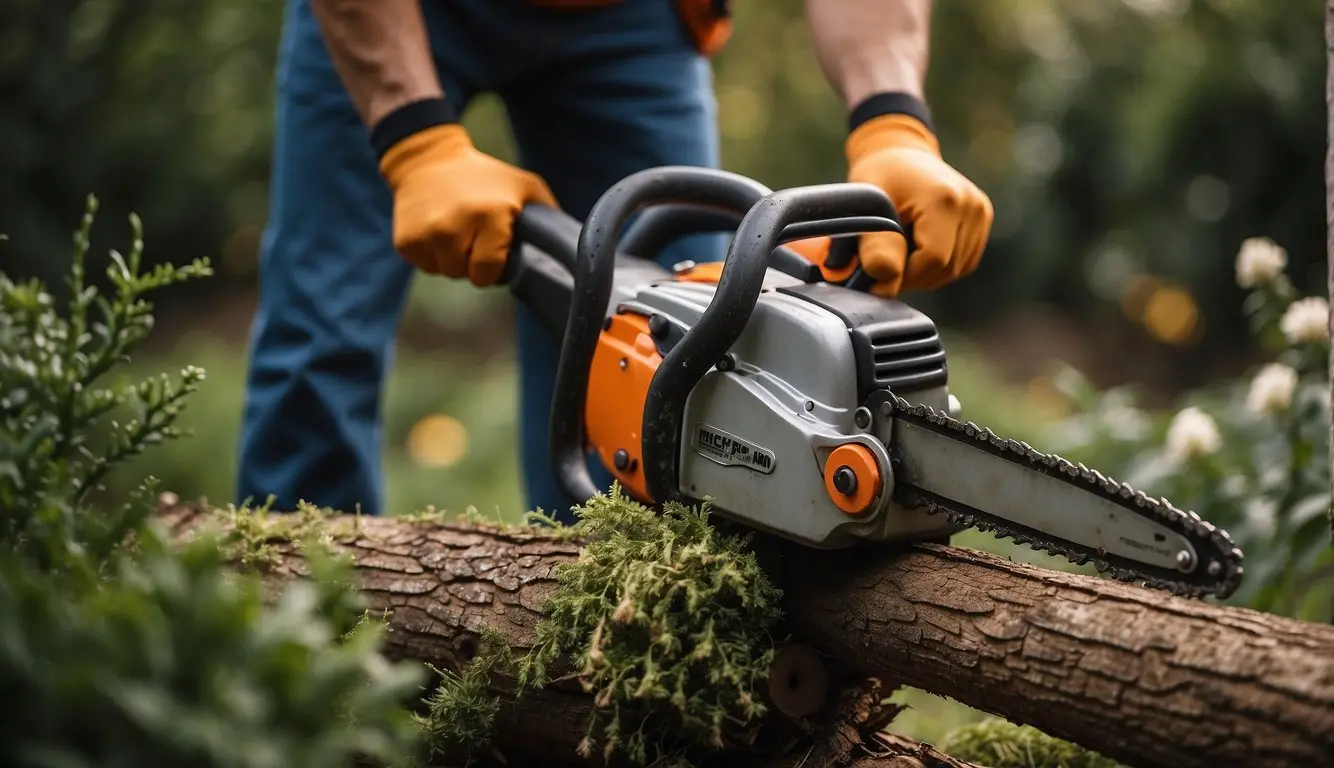
When it comes to pruning small trees and bushes in your garden, selecting the right chainsaw is important. Here are some factors to consider when choosing the right chainsaw for your small garden:
Factors to Consider
- Weight: A lightweight chainsaw is easier to handle and maneuver, especially when pruning trees and bushes. Consider a chainsaw that weighs less than 10 pounds for easy handling.
- Power: A chainsaw with enough power to cut through small branches and logs is important. Look for a chainsaw with a motor that is at least 6 amps and a chain speed of 25 feet per second.
- Price: Chainsaws come in different price ranges. Consider your budget when selecting the right chainsaw for your small garden.
- Compact: A compact chainsaw is ideal for pruning small branches in tight spaces. Look for a chainsaw with a bar length of 10 inches or less for easy maneuverability.
- Selection: There are different types of chainsaws to choose from, including gas-powered, battery-powered, and electric chainsaws. Consider your needs and preferences when selecting the right chainsaw for your small garden.
Comparing Power Sources
- Gas-powered: Gas-powered chainsaws are powerful and effective, making them ideal for heavy-duty pruning tasks. However, they are also heavy and noisy, and require regular maintenance.
- Battery-powered: Battery-powered chainsaws are lightweight and easy to handle, making them ideal for small gardens. They are also quiet and require less maintenance than gas-powered chainsaws. However, they may not be as powerful as gas-powered chainsaws and require recharging after a certain amount of use.
- Electricity: Electric chainsaws are lightweight and easy to handle, making them ideal for small gardens. They are also quiet and require less maintenance than gas-powered chainsaws. However, they may not be as powerful as gas-powered chainsaws and require a power source nearby.
Overall, selecting the right chainsaw for your small garden requires considering factors such as weight, power, compactness, power source, selection, and price. By understanding the benefits and advantages of each type of chainsaw, you can select the right one for your needs.
Pruning Techniques and Tips
When it comes to chainsaw pruning techniques for small gardens, there are a few things you need to keep in mind to ensure that you make clean and precise cuts that promote healthy growth. In this section, we’ll cover cutting angles and techniques, as well as pruning different tree types.
Cutting Angles and Techniques
To make precise cuts, you need to use the right cutting angle and technique. For small branches, you can use loppers, but for larger branches, you’ll need a chainsaw. Make sure your chainsaw is sharp and professional-grade to achieve precision and speed.
When making a cut, always position yourself to the side of the branch, not directly underneath it, to avoid accidents. Start by making a small cut on the underside of the branch, then finish by cutting from the top. This way, you’ll prevent the bark from tearing and ensure a clean cut.
Pruning Different Tree Types
Different tree types require different pruning techniques. For example, deciduous trees should be pruned in late winter or early spring, while evergreen trees can be pruned year-round. Fruit trees should be pruned in late winter to promote healthy growth and increase yield.
When pruning, always start with dead or diseased branches, then move on to branches that are crossing or rubbing against each other. Lastly, trim back any branches that are growing too close to the trunk to promote healthy growth.
In summary, chainsaw pruning requires precision and care to achieve healthy growth in small gardens. By following these pruning techniques and tips, you can ensure that your pruning process is effective and efficient.
Optimizing Your Pruning Time
When it comes to pruning your garden trees, you want to make sure you’re doing it in the most efficient and effective way possible. Here are some tips to help you optimize your pruning time and get the best results for your small garden.
Efficient Pruning Strategies
To make the most of your time, it’s important to have a plan before you start pruning. Take a look at your trees and decide which branches need to be removed and which ones should stay. This will help you avoid unnecessary cuts and save you time in the long run.
Another efficient pruning strategy is to use the right tools for the job. A chainsaw can be a great tool for pruning larger branches, but it’s important to choose the right size and type of chainsaw for the job. For small garden trees, a mini chainsaw or garden pruning chainsaw may be more appropriate. These smaller chainsaws are lightweight and easy to maneuver, making them ideal for small pruning jobs.
Timing Your Pruning for Best Results
Timing is everything when it comes to pruning your garden trees. Pruning at the wrong time of year can have a negative impact on tree growth and overall health. For most trees, the best time to prune is during the dormant season, which is typically in late winter or early spring.
Pruning during the dormant season allows the tree to focus its energy on new growth in the spring. It also reduces the risk of disease and insect infestations, as the wounds from pruning will heal more quickly during the growing season.
In conclusion, by following these efficient pruning strategies and timing your pruning for the best results, you can ensure that your garden trees remain healthy and beautiful year after year.
Maintenance and Care of Your Chainsaw
Maintaining and caring for your chainsaw is crucial to ensure its longevity and performance. Here are some essential tips on chainsaw maintenance that will help you keep your tool in top shape.
Regular Chainsaw Maintenance
Performing regular maintenance on your chainsaw is essential to keep it running smoothly. Before each use, check the air filter and clean it if necessary. A dirty air filter can cause the engine to run poorly, reducing its lifespan. Also, check the chain tension and adjust it if needed. A loose chain can cause damage to the chainsaw and be dangerous to use.
After each use, clean the chainsaw thoroughly and remove any debris or sawdust from the chain, sprocket, and guide bar. Wipe down the chainsaw with a clean cloth and make sure it’s free of any dirt or grime. Check for any leaks in the oil and fuel tanks and keep your chainsaw clean.
Sharpening the Chain
A dull chain can cause the chainsaw to work harder, reducing its lifespan and making it more dangerous to use. To sharpen the chain, you can use a chainsaw file, a chainsaw sharpener, or take it to a professional. It’s important to sharpen the chain at the correct angle and depth to ensure precision cutting.
To sharpen the chain with a file, remove the chain from the chainsaw and secure it in a vice. Use a round file to sharpen each tooth at the correct angle, and then use a flat file to level the depth gauges. Be sure to wear gloves and eye protection while sharpening the chain.
In summary, regular maintenance and sharpening of the chain are crucial to keep your chainsaw working efficiently and safely. By following these maintenance tips, you can ensure that your chainsaw lasts longer and performs better.
Pruning for Tree Health and Garden Aesthetics
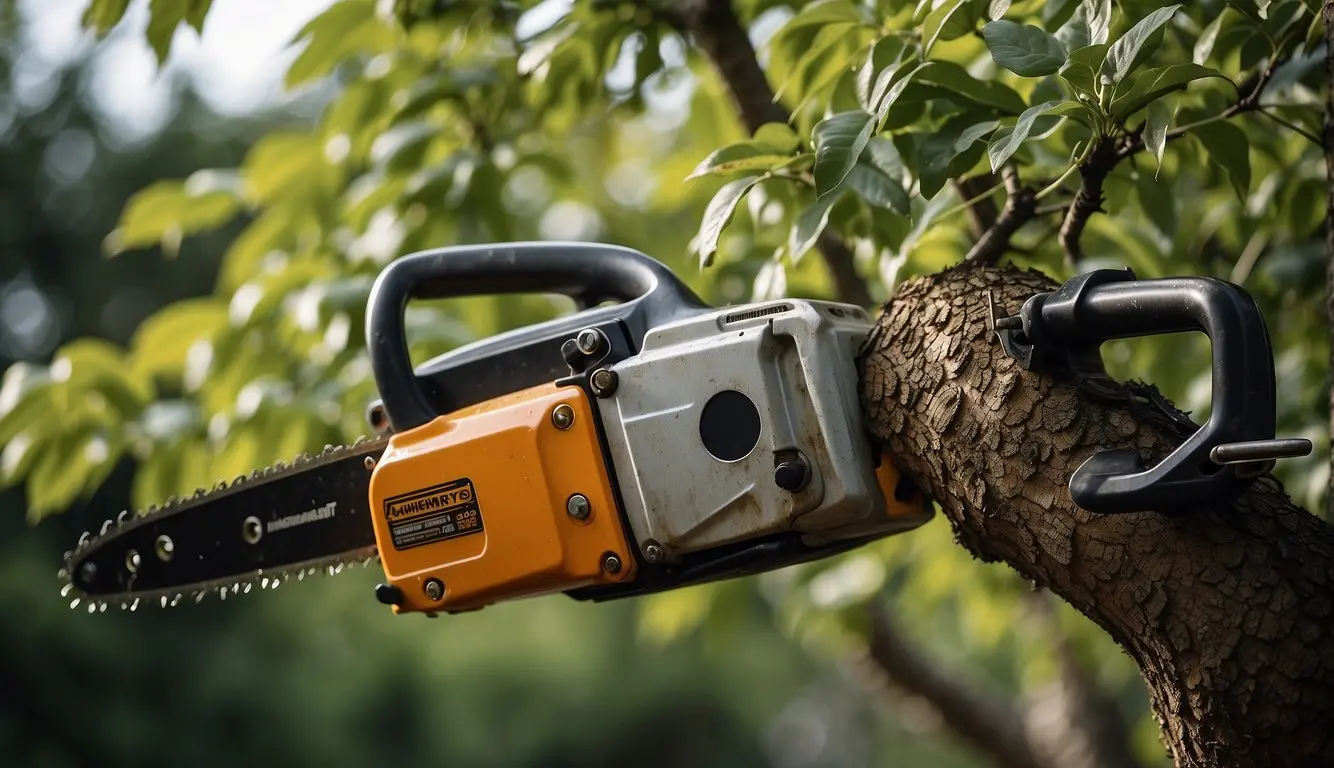
When it comes to maintaining a small garden, pruning is an essential practice that promotes the health, structure, and aesthetics of your trees. Proper pruning techniques not only enhance the beauty of your landscape but also ensure the long-term vitality and safety of your trees.
Promoting Healthy Growth
Pruning is a crucial aspect of maintaining healthy trees. Regular pruning helps to remove diseased or damaged branches, which can be a source of infection for the rest of the tree. It also helps to promote healthy growth by removing weak or poorly positioned branches that can interfere with the growth of other branches.
To promote healthy growth, it is important to prune your trees at the right time. For most trees, the best time to prune is in late winter or early spring when the tree is still dormant. This allows you to see the structure of the tree more clearly and makes it easier to identify any problem areas.
Shaping and Controlling Plant Size
In addition to promoting healthy growth, pruning can also be used to shape and control the size of your trees. This is especially important in small gardens where space is limited. By removing branches that are growing in the wrong direction or are too close to other branches, you can create a more open and attractive canopy.
There are several pruning techniques that can be used to shape and control the size of your trees. These include:
- Crown reduction: This involves removing the upper branches of the tree to reduce its overall height and size.
- Crown thinning: This involves removing some of the smaller branches within the canopy to allow more light and air to reach the tree’s interior.
- Crown raising: This involves removing the lower branches of the tree to create more space beneath the canopy.
It is important to note that pruning can be a labor-intensive task, especially for larger trees. If you are not comfortable pruning your trees yourself, it is best to hire a professional arborist to do the job for you.
By using proper pruning techniques, you can promote healthy growth and create an attractive and functional garden space. As a gardener, it is important to prioritize the health of your trees and invest the time and effort needed to maintain them properly.
Troubleshooting Common Chainsaw Issues
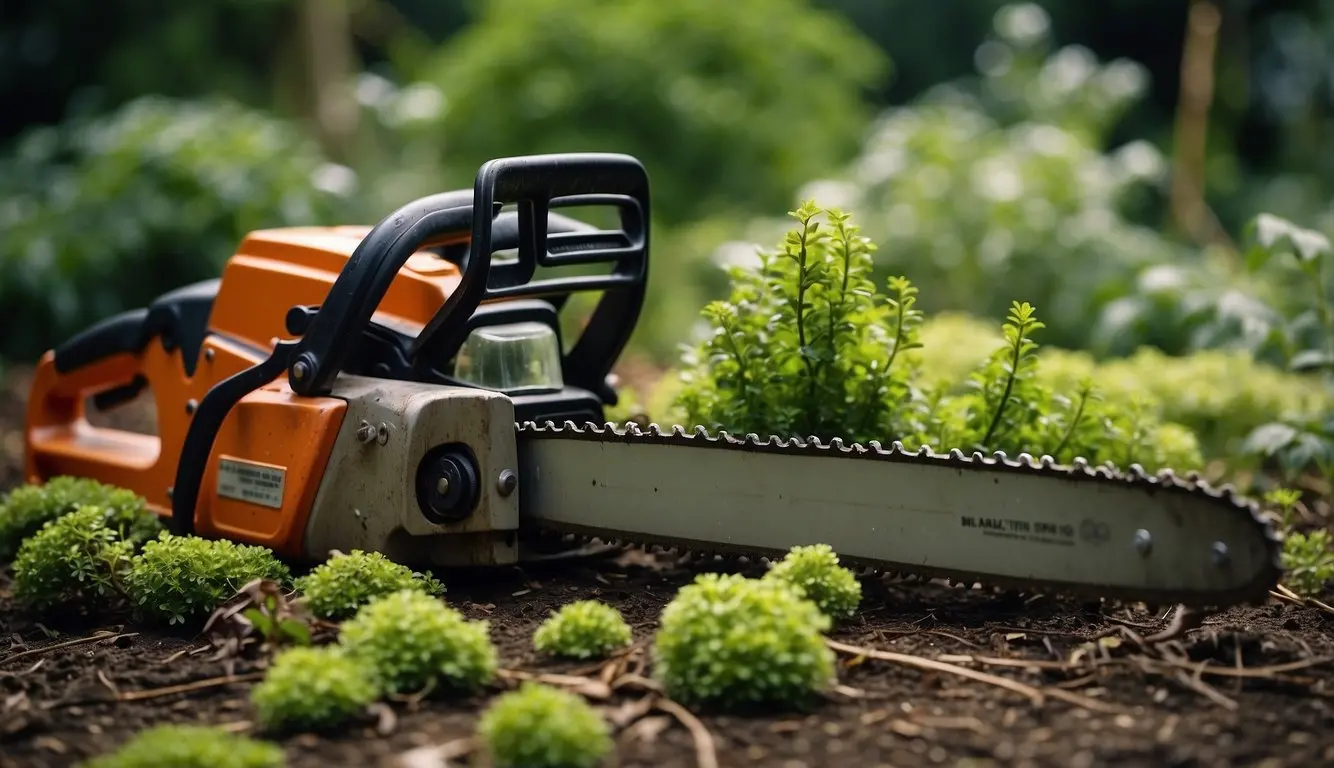
When it comes to chainsaw pruning, it’s essential to have a properly functioning tool. Here are some common chainsaw issues and how to troubleshoot them.
Dealing with Chainsaw Kickback
Chainsaw kickback is a sudden and violent upward motion of the chainsaw bar. It can be dangerous and cause serious injury. To prevent kickback, make sure the chainsaw’s chain brake is engaged and the saw’s handle is firm. Always keep the chainsaw’s cutting teeth sharp, and avoid cutting with the chainsaw’s tip.
If you experience kickback, it may be due to a dull chain, incorrect chain tension, or a damaged guide bar. Check the chain and guide bar for any damage or wear and replace them if necessary. Adjust the chain tension as per the manufacturer’s instructions.
Resolving Tension and Cutting Problems
Chainsaw tension problems can cause the chain to come off the guide bar or slip while cutting. To prevent this, make sure the chain is properly tensioned and lubricated. Check the chain tension regularly and adjust it as needed.
If the chainsaw is having trouble cutting, it may be due to a dull chain or improper chain lubrication. Check the chain for any dull teeth and sharpen them if necessary. Make sure the chain is properly lubricated, and the oil reservoir is full.
When cutting logs, make sure you are using the proper cutting technique. Cut logs from the top down, and avoid cutting through the log’s center to prevent the chainsaw from getting pinched. Use a sawhorse or other support to hold the log securely while cutting.
In summary, chainsaw issues can be dangerous and prevent you from achieving a clean cut. By following these troubleshooting tips, you can ensure your chainsaw is in good working condition and ready for pruning any wood in your small garden.
Handling and Maneuverability in Tight Spaces
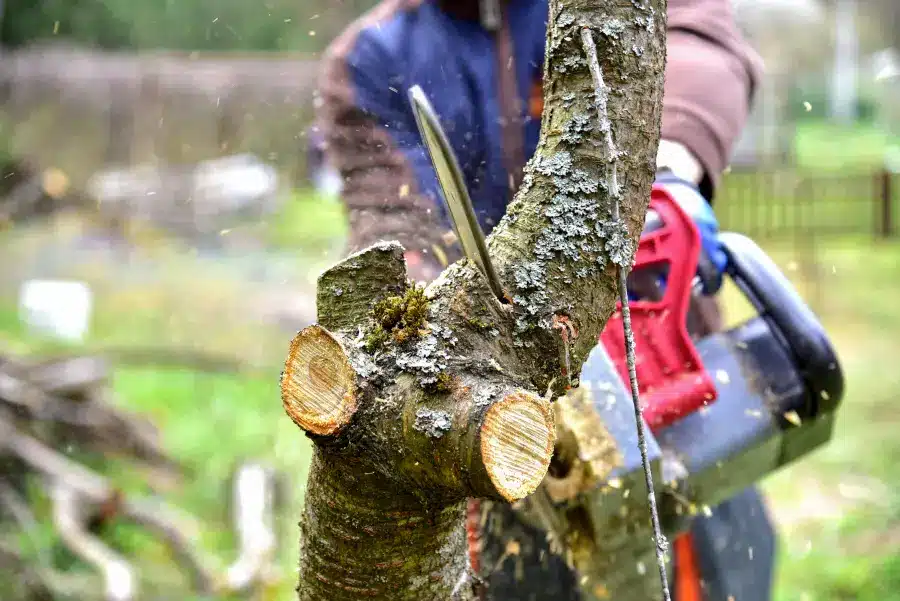
When it comes to pruning trees and branches in small gardens, maneuverability and control are essential. You need to be able to work comfortably and efficiently in tight spaces without causing damage to your plants or property. Here are some tips for handling and maneuverability when using a chainsaw for pruning in small gardens.
Working with Compact Chainsaws
Compact chainsaws are lightweight and designed for easy maneuverability in tight spaces. They are ideal for pruning small trees and branches in small gardens. Their lightweight design allows you to work for extended periods without fatigue, and their compact size makes them easy to store when not in use.
Navigating Small Garden Spaces
When working in small garden spaces, it’s essential to have a chainsaw that is easy to maneuver. You need to be able to move around obstacles and work in confined spaces without damaging your plants or property.
To navigate small garden spaces, you need to have a good grip on your chainsaw. Make sure that you have a comfortable grip that allows you to maintain control over the tool. You should also wear appropriate safety gear, including gloves and eye protection, to prevent accidents and falls.
In addition, it’s crucial to be aware of your surroundings when pruning in small garden spaces. You should be mindful of any obstacles, such as rocks or roots, that could cause you to lose your balance or trip. By being aware of your surroundings and taking the necessary precautions, you can safely and efficiently prune trees and branches in small gardens.
Frequently Asked Questions
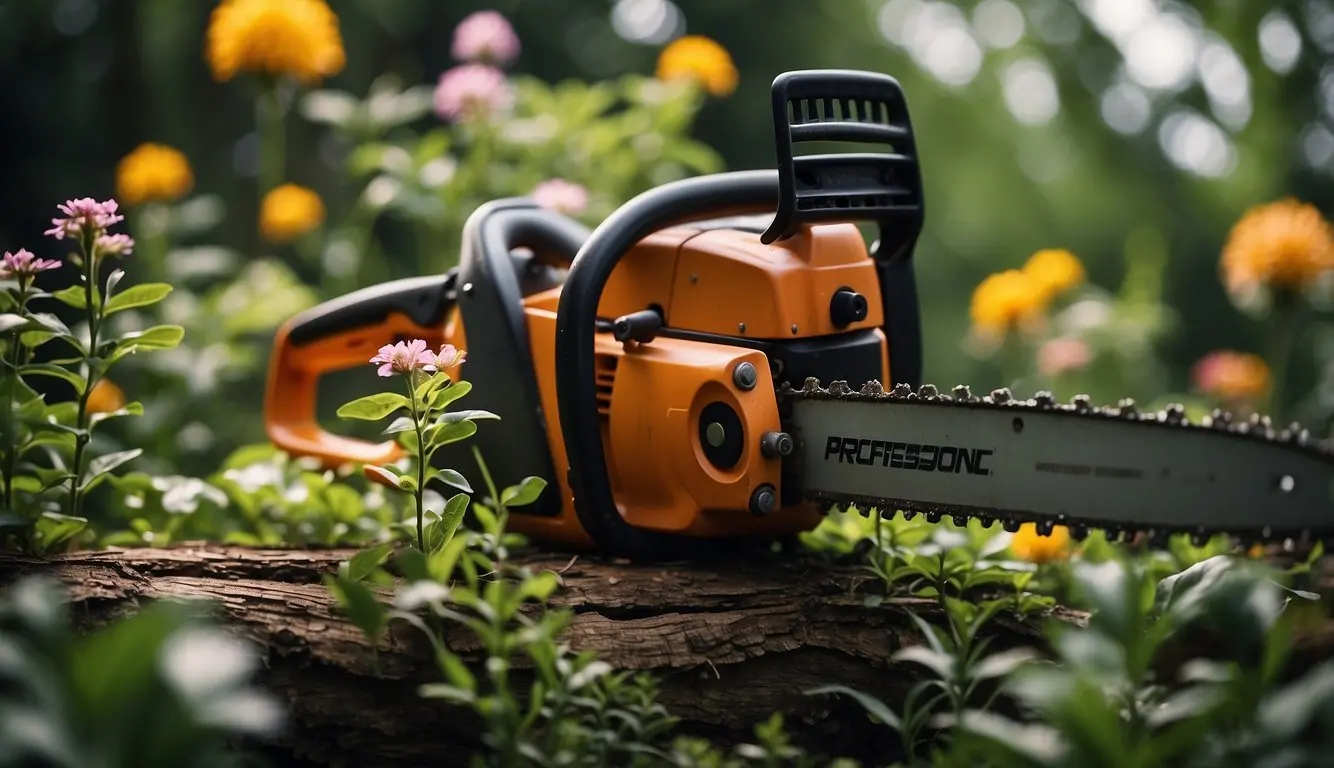
What safety precautions should be taken when pruning with a chainsaw in a small garden?
Pruning with a chainsaw can be dangerous, so it’s important to take safety precautions. Some of the essential precautions include wearing protective gear such as gloves, safety glasses, ear protection, and a hard hat. Always ensure that the chainsaw is in good condition, and the chain is sharp. Keep the chainsaw away from children and pets, and never operate it while standing on a ladder. Additionally, it’s essential to keep your work area clear of debris and obstacles.
How can one effectively cut high tree limbs with a chainsaw?
Cutting high tree limbs with a chainsaw can be challenging, but it can be done safely and effectively. One of the best ways to do this is by using a pole saw attachment. A pole saw is a chainsaw attached to a long pole, which allows you to reach high branches without having to climb a ladder. You can also use a ladder to reach high branches, but it’s important to ensure that the ladder is stable and secure before climbing.
What is the proper technique for cutting large branches with a chainsaw to avoid pinching?
When cutting large branches, it’s essential to use the proper technique to avoid pinching. The first step is to make an undercut on the branch, about a third of the way through. Then make a top cut about two inches further down the branch from the undercut. This will cause the branch to break off between the two cuts, preventing the chainsaw from getting pinched.
Is it advisable to use a chainsaw for trimming bushes, and if so, how?
While chainsaws are primarily used for cutting trees, they can also be used for trimming bushes. When using a chainsaw for trimming bushes, it’s important to use a smaller chainsaw and a shorter bar. Start by removing any dead or diseased branches, and then trim the remaining branches to the desired shape. Always wear protective gear and keep your work area clear of debris.
Can electric chainsaws be used for pruning in small gardens, and what are the best practices?
Electric chainsaws can be used for pruning in small gardens, and they offer several advantages over gas-powered chainsaws. They are quieter, lighter, and easier to maintain. When using an electric chainsaw for pruning, it’s important to use an extension cord that is rated for outdoor use and has a ground fault circuit interrupter (GFCI). Always follow the manufacturer’s instructions for use and maintenance.
What does drop crotching involve, and how can it be applied to chainsaw pruning?
Drop crotching is a pruning technique that involves removing the central leader of a tree and allowing two or more lateral branches to take its place. This technique is often used to reduce the height of a tree or to create a more balanced shape. To apply this technique to chainsaw pruning, start by making a cut on the central leader about 12 inches above the desired height. Then make a second cut about 6 inches below the first cut. This will cause the central leader to drop, and the lateral branches will take over.
- Best Brush Cutter: Top 5 Models for Lawn Maintenance in 2024 - January 10, 2024
- Best Chainsaw Pruning Techniques for Small Gardens: Expert Tips - November 14, 2023
- Future Chainsaw Innovations: Advancements in Efficiency and Safety - November 12, 2023